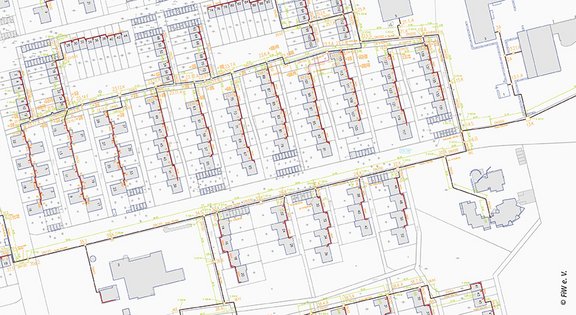Climate-damaging emissions due to fossil electricity and heat generation are facing increasing criticism. In order to achieve the climate targets, recently set in 2016 in the Federal Government's Climate Protection Plan, the emission of climate-active emissions must be reduced considerably. This applies directly to the electricity sector. However, the heating sector, as it lags behind the electricity sector in terms of renewable, low-emission energy sources, will have to develop even more strongly in upcoming years. The comprehensive use of renewable energies, also in the heat supply, is therefore an elementary necessity from the perspective of climate protection as well as the practical implementation of the energy transition.
However, in order to enable a long-term climate-neutral and energy-efficient heat supply locally, possibilities for using renewable energies, such as solar thermal energy, for heat supply must be investigated.
Fourth-generation heating network systems are considered as innovative heating infrastructures that are designed to optimise losses and temperature. The often outdated supply structures must be adapted to new requirements, resulting in a high potential for optimisation. The optimisation of older heating grids and the digitalisation of plants and grids can reduce emissions and, in particular, also have economic benefits.
The FiW services in the context of the "heat" projects:
- Location/site investigation incl. estimation of the individual, consumer-specific heat demand
- Creation and simulation of heat network models
- Concept development for innovative and sustainable heat supply incl. sector coupling
- Concept development for short- and long-term heat storage
- Climate compatibility assessment
- Economic feasibility study
With the help of solar heat generation, today's heating networks can be operated not only regeneratively, but also CO2-free and competitively priced.
In the project SolNahWal (Solar Local Heating Supply Walheim), an R&D project funded by BAFA and STAWAG, e.g. the new construction of a fourth generation heating network is investigated. The focus of this project is on heat generated by solar thermal energy as well as the feasibility of storing it in long-term heat storage tanks in connection with local heating networks. For this purpose, the heat demand was estimated on the basis of consumption and modelled building data. On this basis, a heat network model was created and various simulations were carried out to optimise the temperature level and the resulting losses, as well as a technical, innovative and sustainable generation concept.
Goal and outlook
Digital heat network models should also be used for new construction and expansion measures in the future. At the same time, the digitalisation or simulation and modelling of existing heating networks offers the possibility of efficient and demand-oriented heat supply as well as continuous optimisation of the network on the basis of predictive network condition investigations.
The FiW and its project partners are discussing the further development of measurement and control concepts as well as possibilities for sector coupling.





